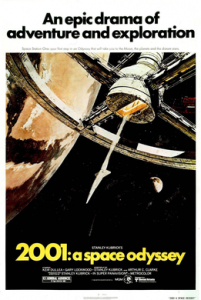
Envisioning 2001: Stanley Kubrick’s Space Odyssey
Museum of the Moving Image (MoMI)
36-01 35 Avenue Astoria, NY 11106
718 777 6800
movingimage.us
Devoted to one of the most influential films ever made, Envisioning 2001: Stanley Kubrick’s Space Odyssey opens at Museum of the Moving Image (MoMI), in its North American debut, on January 18, 2020.
Of the many media concepts that evolved into iconic and predictive idea factories, there’s three that always pop into mind: “Star Trek,” Apple Computers and the film 2001: A Space Odyssey.” They all envisioned a future in their creation — and in some cases, ongoing evolution — where many of the ideas embraced by these properties not only hit the mark but actually redefined the mark to be hit.
Of the three, Kubrick’s revolutionary film did in one relatively short burst — it’s 142 minutes long — what took years and many products for the other two to do, and it changed so much of what we think and how we behave.
I consider it a near perfect piece of cinema and it does what cinema is supposed to do; allow us to experience something that couldn’t be experienced in commonplace life. At that time, in fact at this time as well, the film spurred a true suspension of disbelief and allowed a viewer, willing to do so, to experience a true shift in consciousness. With the right attitude, one was offered a chance to view this narrative not from a human viewpoint but that of the other, of the prime movers, of the aliens who are interacting with humanity. The film provides such a profound consciousness shift that it does what few films rarely do — allow us to experience a reality that can only experienced by seeing it. Now with digital technology enabling filmmakers in ways never thought possible in 1968, others come close to what Kubrick did without those tools at hand.
To give a plot summary almost does it a disservice but here it it is. Aliens have planted devices in various locations that track and may influence human evolution. Once humankind voyages into space and launched colonies on the moon and elsewhere, these aliens provoke us to launch a mission to Jupiter. That mission is the part of a step in changing human evolution.
Kubrick spent five years developing this film, having connected with science fiction writer Arthur C. Clarke whose novel Childhood’s End, told of an alien race which assist mankind. After meeting Clarke in New York City in April 1964, Kubrick suggested they work on his 1948 short story The Sentinel, about a tetrahedron found on the Moon which alerts aliens of mankind.
The exhibition includes original artifacts from international collections and from the Stanley Kubrick Archive at the University of the Arts London, as well as from the Museum’s own collection. The exhibition explores Kubrick’s influences, his obsessive research, and his innovative production process in envisioning a world of the future—the year 2001 from the viewpoint of the 1960s.
Organized by the DFF – Deutsches Filminstitut & Filmmuseum in Frankfurt am Main (where a version of the exhibition debuted in 2018), in partnership with the Stanley Kubrick Archive at University of the Arts London and with support from Warner Bros.

Throughout its six-month MoMI run, this exhibition will be accompanied by a wide variety of screening series, public programs with guest speakers, specially themed workshops, tours, special events, and more. They include weekly Saturday matinees of 2001: A Space Odyssey; monthly 70mm screenings of 2001 with guest speakers; the film series “Influencing the Odyssey: Films that Inspired Stanley Kubrick and Arthur C. Clarke” (Jan 17–Feb 2), “See It Big! Outer Space” (Feb 7–Apr 26), and “Science on Screen: Outer Space Speculators” (Feb–July, monthly).
Made before the first moon landing, Kubrick’s 1968 film, was developed in collaboration with writer Arthur C. Clarke. It depicts the fraught relationship between humanity and technology, using pioneering special effects.
Said MoMI Executive Director Carl Goodman, “2001: A Space Odyssey has influenced generations of directors and artists, and continues to captivate audiences around the world. We are proud to be the first North American museum to present this remarkable exhibition. It is especially fitting that this exhibition will be presented here at MoMI, where screening 2001 in its original 70mm format has become an annual tradition, and our public spaces, including the spectacular Redstone Theater, are deliberately evocative of the film.”
Exhibition highlights include Special Photographic Effects Supervisor Douglas Trumbull’s concept sketches for Clavius Base, from MoMI collection; costumes, including a space suit worn in the Clavius Base scene and Moonwatcher ape suit worn by Dan Richter in the Dawn of Man scene; and storyboards, contact sheets, test films, and photographs related to the Stargate special effects sequence.
Tickets for the exhibition Envisioning 2001: Stanley Kubrick’s Space Odyssey are on sale now at movingimage.us/2001tickets. Timed-entry tickets include general Museum admission and are free or discounted for Museum members.
For more information go to: movingimage.us
